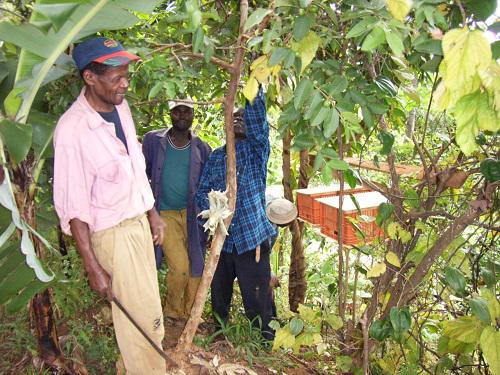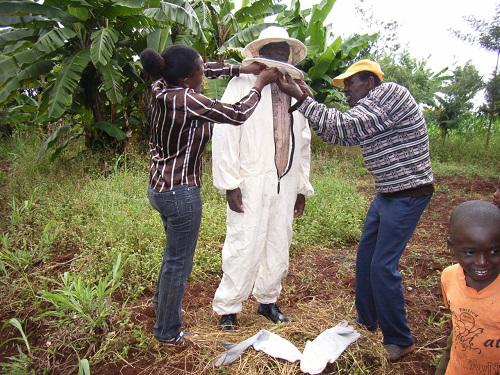Jasper Mbae Kirika & Flora Njeri Namu
Other projects
18 Dec 2007
Integrated Community Conservation of Biodiversity in Agro-Ecosystems Adjacent to the Eastern Side of Mount Kenya Forest
To promote conservation of biodiversity and improve community livelihoods through; planting trees, modern bee-keeping, documentation of indicator species and advocacy.

A farmer inspecting his new bee hives, immediately after hanging.
The agro-ecosystems east of Mt. Kenya forest have lost their natural vegetation due to cash and food crops growing up to the river banks. These together with climate change have resulted in drying up of some streams, soil erosion and landslides. Data collected during the First RSG project showed that several bird species previously found in the region were absent. In addition, abundance of birds and pollinators was low with stingless bees absent. Modern honey beekeeping is limited due to lack of information/skills. To promote conservation of these species, restore ecosystem processes and functions as well as improve community livelihoods, the following activities will be carried out:

A beekeeper being shown how to wear a new bee suit.
Species documentation
Further surveys of indicator species in different habitats will be carried out in wet and dry seasons. Food sources and breeding sites for different species will be recorded to give insights into which plants need to be replanted and the sites which require protection. Some members of the community will be trained on sampling and identification of indicator species. In addition a thorough search for stingless bees with a view to domesticating them for honey production will be carried out.
Environmental education
Community members (groups)who will be responsible for training the rest of the community will be trained on all aspects of this project. The project team and the trained groups will work together to create awareness on climate change.
Community bee keeping
Modern hives will be issued at a subsidized price to community members using log hives. Subsidizing rather than giving will ensure members are more responsible.
Tree nurseries
More tree nurseries will be established in cooperation with community members. Priority will be given to multipurpose trees and plants that were found to be important during species documentation.
Sampling of drought resistant crops
This will be done through interviewing community members especially the older generation.
We plan to continue monitoring of indicator species around Mount Kenya forest to conserve biodiversity both in the forest and adjacent agricultural landscapes. The monitoring will guide environmentalists as well as agriculturalists in making decisions and policies regarding biodiversity in the agro-ecosystems. We also intend to build the community awareness to environmental matters and capacity to cope with climate change by starting an environmental and biodiversity awareness centre. In addition we plan to empower the local communities economically through diversification and marketing of income generating activities.